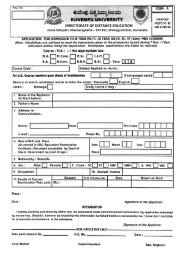KUVEMPU UNIVERSITY M.Sc. CHEMISTRY (Final Year)
KUVEMPU UNIVERSITY M.Sc. CHEMISTRY (Final Year)
KUVEMPU UNIVERSITY M.Sc. CHEMISTRY (Final Year)
You also want an ePaper? Increase the reach of your titles
YUMPU automatically turns print PDFs into web optimized ePapers that Google loves.
<strong>KUVEMPU</strong> <strong>UNIVERSITY</strong>OFFICE OF THE DIRECTORDIRECTORATE OF CORRESPONDENCE COURSESJnana Sahyadri, Shankaraghatta – 577 451, KarnatakaPhone: 08282-256246, 256426: Fax: 08282-256370; Website: www.kuvempuuniversitydde.orgE-mail: info@kuvempuuniversitydde.org, ssgc@kuvempuuniversitydde.orgTOPICS FOR INTERNAL ASSESSMENT ASSIGNMENTS - 2007-08M.<strong>Sc</strong>. <strong>CHEMISTRY</strong> (<strong>Final</strong> <strong>Year</strong>)Note: Students are advised to read the separate enclosed instructions before beginning thewriting of assignments.Out of 15 Internal Assignment marks per paper, 5 marks will be awarded for regularity(attendance) to Counseling/ Contact Programme/ Practical classes pertaining to thepaper. Therefore, the topics given below are only for 10 marks each paper.Instructions: 1. Answer the following questions, illustrate wherever necessary.2. Breakup marks are as given along with the topic.Paper- 5: DECHEM 2.01- ANALYTICAL <strong>CHEMISTRY</strong>PART-A: Answer ANY ONE of the following(1 x 10 = 10 Marks)1. a) What are symmetry elements and symmetry operations? Explain.b) Give the procedure for classification of molecules into point group.c) Explain the application of group theory in spectroscopy2. a) Explain the system configuration of computer.b) Give the application of computer in chemistry.3. a) What is an electromagnetic radiation/ Explain the width and intensity of spectual linesduring interaction of electromagnetic radiation with matter.b) Discuss the energies corresponding to various kinds of radiations, moleculartransactions and selection rules in spectroscopy.PART-B: Answer ANY ONE of the following1. a) Explain the basic principles of ESR spectroscopy.b) Explain zero field splitting and Krammer’s degeneracy.2. a) Explain the modes of fragmentation in mass Spectrometryb) Discuss various types of burners encountered in flame photometry.(1 x 10 = 10 Marks)3. a) Discuss various factors influencing chemical shift and spin-spin coupling in NMRspectroscopy.Paper-6: DECHEM 2.02 - INORGANIC <strong>CHEMISTRY</strong>PART-A: Answer ANY ONE of the following(1 x 10 = 10 Marks)1. Explain crystal field stabilization of EAN rule? On the basis of EAN rule discuss thestructure and stability of Ni, Co, Fe and Mn carbonyls.2. What are electron transfer reactions? With illustrative example explain the mechanism ofinner and outer sphere electron transfer reactions.3. Discuss the role of alkali earth metals in biological systems
IA Topics 2007-08 - M<strong>Sc</strong> Chemistry (<strong>Final</strong> <strong>Year</strong>) 2PART-B: Answer ANY ONE of the following(1 x 10 = 10 Marks)1. Discuss the theory and applications of Mossbauer spectroscopy.2. Discuss the structure, stereochemistry and oxygenation of Hb and Mb.3. Explain the therapeutic use of metal complexes.Paper – 7: DECHEM 2.03 - ORGANIC <strong>CHEMISTRY</strong>PART-A: Answer ANY ONE of the following1. Discuss the role of DNA and RNA in protein synthesis.(1 x 10 = 10 Marks)2. Discuss the theory and applications of IR and UV-Vis spectroscopy in identification oforganic compounds.3. Explain the different types of molecular rearrangements, write the mechanism andapplications of Claisen, Pinocol-pinocoline and benzyl-benzilic acid rearrangements.PART-B: Answer ANY ONE of the following(1 x 10 = 10 Marks)1. Explain the mechanism of application of Wagner-Meerwein and Cope rearrangements.2. Discuss the structure and synthesisi of nucleosides and nucleotides.3. Write a note on Norrish type-I and Norrish type-II reactions and Paterno-Buchi reaction.Paper-8: DECHEM 2.04 - PHYSICAL <strong>CHEMISTRY</strong>PART-A: Answer ANY ONE of the following(1 x 10 = 10 Marks)1. a) Discuss the basic principles of thermal methods of analysis.b) Explain the simultaneous DTA-TGA curves with an example.c) What is DSC? Explain the factors affecting DSC.2. a) Explain the nuclear fission and fusion reactions.b) Discuss the importance and applications of nuclear models.c) Give an account of nuclear forces, nuclear size, nuclear density, packing fraction andbinding energy of the nucleus.3. a) Give the importance of thermodynamics.b) Explain the concept of entropy in reversible and irreversible processes.c) Discuss Carnot’s cycle, efficiency of heat engine and its importance.PART-B: Answer ANY ONE of the following(1 x 10 = 10 Marks)1. a) Classify different types of polymers and polymerization reaction.b) Explain different experiments for determination of molecular weight.2. a) Discuss rotation-vibration spectra.b) Explain the basic principles of Raman spectroscopy.3. a) Give the physical significance of entropy, work and free energy function and criteriafor reversible and irreversible processed.b) Discuss third law of thermodynamics.*****
















